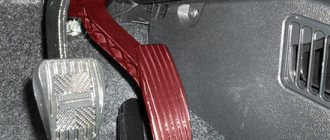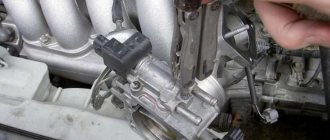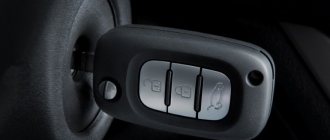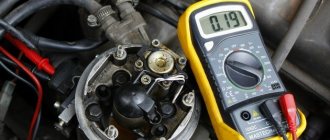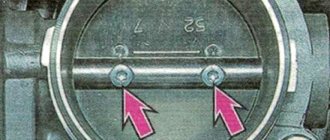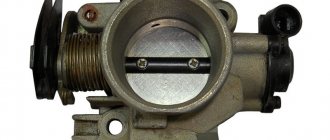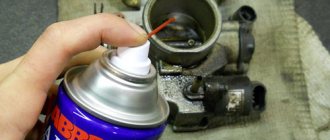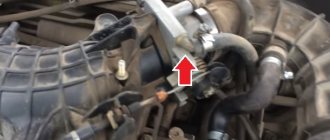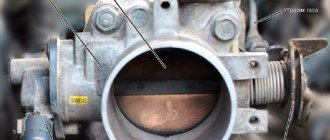March 23, 2018 Lada.Online 226 787 76
Jerking when changing gears or when starting the car. In some cases, adapting the throttle valve zero and adapting the misfire diagnostic function will help solve these problems. The adaptation process does not require special equipment and can be done with your own hands.
Throttle adaptation for Lada Granta 127 engine
And if this is not done, then what will be interesting?
Or can you do this: install the battery, but since it’s cold now, don’t do the adaptation, and when it gets warmer, remove the terminal, then put it back on and do the adaptation?
Also, is it necessary to adapt the misfire function after this?
In general, everything is somehow not right. Okay adaptation. But these are +7 degrees. Drive in emergency mode all winter?
Added after 2 minutes As I understand it, it would be best to have an old battery with you. While I took this one out for charging, I quickly installed the old one to maintain the ECU memory.
Added after 1 minute Or you can also take an unnecessary battery from the UPS - it will be easier, but enough for support.
Source
Problem with idle float when starting on cold due to sticking of throttle 21127 and 21129.
Dear friends, today I’ll tell you about my experience in resolving problems with the throttle assembly. Very relevant, especially for owners of 21129 engines.
By the way, I have the firmware with the problem already fixed.
The occurrence and solution at the plant level in the case of the M74.5 ECU, it was like this. When the ignition was turned on on old versions of the ECU firmware, the micro-calibration time of the Throttle Unit (hereinafter referred to as the remote control) was, well, long, due to the fact that the owner did not wait for a 10-second pause during the ignition, this error occurred.
This problem can be fixed with firmware.
But not everyone, for example, in cars of 13-14 years, the remote control motor was of an old model, had a certain moment of jamming, then in 15 the remote control became “modernized” and this error went away altogether.
Firmware versions that have this problem:
I427DB02 I427DC03 I427DD04 I427DF04 I427DG05 I427GA01 I427GB02 I427GC03 I427GD04 I427GE05 I427GF06
Firmware versions that do not have this problem:
I427GG07 I427GKA1 I427GKA 2
Here is a photo of how to find out your firmware version, the firmware is interchangeable, at least install the oldest one on the new unit, at least the newest one.
Problem with floating XX when starting on cold
The car sits overnight, in the morning you start the revs, when it warms up, the revs begin to jump, +-300 revs, with the probability of stalling, you need to press the gas pedal lightly and everything returns to normal.
Starting the engine, the rpms are 1200, they begin to jump between 500 and 1400 and hang at 700.
Related problems:
— Jerking during a smooth start in first gear — Thoughts in part-load mode — The feeling when accelerating at 50% throttle that sometimes “as if you’re holding your ass”
How to diagnose physically: when disassembling the throttle, remove the plastic gear, twist the motor gear, if it rotates tightly or sticks, then the manual is for you.
It is necessary to remove the remote control, clean the valve (by the way, it was clean) with carburetor cleaner, then remove the cover, unscrew the motor and wash everything.
Source
conclusions
The main cause of failures are spark plugs, but they are not the only ones that influence the appearance of this effect. Some car enthusiasts may not be able to cope with the occurrence of such malfunctions on their own, and it is necessary to go to a car service center, where they will carry out high-quality diagnostics and also fix the problem. But at the same time, it is worth considering that you will have to be generous, since neither the repair nor the repair will cost a penny.
Good day! Question for those who have encountered this problem. So I’ll start from afar to make the situation more clear. In general, I wrote earlier that I had a problem with the fact that at a traffic light the speed dropped to 500, then rose to 1200, then leveled off and everything started in a circle several times, and if I left it on hot, at idle, it could stall altogether, but it stalled softly, as if they had simply turned the key, and the canister purge valve was also clicking. I went through various diagnostics for a long time, in the end they found an air leak through the rubber bands of the receiver, changed the IAC, washed the throttle, changed the filter and mesh, after this replacement curve the fuel pump whistled, failures seemed to become less frequent, but it still stalled and only when it was hot, when I left it on single. As a result, I got to one diagnostician, he found a bent throttle valve, did the firmware and the car seemed to drive, the fuel pump stopped whistling after a month and a half. Everything seemed to be fine, but over time I began to notice such a thing that when the tank needle is in the red zone, the car seems to have been replaced, it starts to drive very cheerfully with less pressure on the gas pedal, plus there is clearer information from the pedal and less roar of the engine when accelerating. .e. even from the bottom (1.4 engine) it accelerates with a pleasant sound, and not with a fart that is about to die. BUT, as soon as you fill gasoline above the red zone, the car becomes sluggish, when accelerating in second gear, the car does not respond to how much the gas pedal is pressed, whether the pedal is to the floor, or until half the acceleration speed does not change, the speed rises somehow slowly, but if you pump the gas pedal with your foot several times, you can achieve a slight acceleration, but still not as much as on an empty tank (for the difference in weight of 30 liters, I think it’s stupid to say what will affect acceleration). Plus, when accelerating from the bottom, there is an unpleasant, sort of slightly farting sound from the engine (not the exhaust), it feels like it’s missing either air or gasoline. I drove like this for almost a year, I couldn’t find the reason, there were similar topics on the service and on the Internet, but there were no concrete solutions, most people simply don’t believe that the car can drive more vigorously on an empty tank. There is no air or other stuff in the tank. Recently the fuel pump whistled again, but the car drove briskly and on a full tank, so the pump was still original since 2009, I decided that the problem was in it and changed it, it seemed to start running, then I found a topic about the RTD and also changed it to catch up. The car came to life with any tank, drove like that for a week and a half and went to another city on the highway, everything was great, the acceleration was excellent, I didn’t even notice how quickly it picked up to 150. BUT, after driving about 70-80 kilometers, I began to notice that something was wrong again, when I was driving back I had to stoke in third to overtake
In general, now I don’t know where to dig, the car now drives according to its mood, no matter how many liters are in the tank, for example, I leave for work in the morning, it’s dull, the gas is on the floor, and like a pensioner it accelerates slowly, I leave it in the parking lot, in the evening I go out and it drives cheerfully with slipping in second and third gear, as if the engine had been changed. So far I can’t catch any pattern (if before it was based on the level of gasoline in the tank)
I also forgot to write that even after replacing the RTD with a hot one, in half the cases it starts poorly, you have to squeeze the gas. I only drive on gasoline; I don’t have gas equipment. Anyone who has encountered such a problem or knows what could be the reason, please tell me.
www.drive2.ru
When and how to do it yourself
When to do it
adaptation of the throttle valve zero and adaptation of the misfire diagnostic function:
- After replacing the ECU controller or resetting the controller using a scan tool.
- After replacing the throttle assembly.
Throttle zero adaptation procedure
:
- When the car is stationary, you must turn on the ignition, wait 30 seconds, turn off the ignition, wait until the main relay turns off.
Adaptation will be interrupted
, If:
- the engine turns over;
- the car is moving;
- the accelerator pedal is pressed;
- engine temperature is below 5 °C or above 100 °C;
- Ambient temperature is below 5 °C.
Adaptation procedure
Misfire diagnostic functions:
- warm up the engine to operating temperature (parameter value “Coolant temperature” = 60.90 °C);
- accelerate the car in 2nd gear until higher crankshaft speeds are reached (parameter value “Engine crankshaft speed” = 4000 min-1) and perform engine braking (“Engine crankshaft speed” = 1000 min-1);
- Perform engine braking six times in one trip.
This adaptation procedure is specified in the technological instructions for LADA cars.
Self-cleansing procedure
If the damper is electronically actuated, then it is better to remove the negative terminal of the battery. Next, you can do everything according to simple instructions:
- dismantle the air filter by unscrewing the pipe clamp;
- disconnect all connectors of the throttle module and other pipes;
- move the air filter receiver to the side so that it does not interfere, and begin cleaning the damper;
- upon completion, reassemble the damper module in reverse order, checking that everything is in place;
- After assembly, start the engine and check the idle speed.
In some cases, before you begin to adapt the throttle valve on a Toyota, Nissan or Skoda, it is necessary to remove the throttle itself, which allows you to completely clean the valve. To do this, you will need a 5 mm hexagon to unscrew the 4 fasteners. Removing the throttle should be done with great care, as there is a risk of damaging the gasket.
If, after cleaning the throttle body, increased idle speed is observed, it means that the damper needs to be adapted. What this is is further in the topic of the article.
Owner reviews
Owners of LADA XRAY who independently performed the throttle valve zero adaptation procedure note that the car stopped twitching and acceleration became smooth.
Some reviews from Drive2.ru (link to post):
Let us remind you that we previously published an information letter from AVTOVAZ, which tells us what to do in case of vibrations and jerks when starting off a LADA car.
Share on social networks:
Found an error? Select it and press Ctrl+Enter..
Source
When and how to do it yourself
When to do it
adaptation of the throttle valve zero and adaptation of the misfire diagnostic function:
- After replacing the ECU controller or resetting the controller using a scan tool.
- After replacing the throttle assembly.
Throttle zero adaptation procedure
:
- When the car is stationary, you must turn on the ignition, wait 30 seconds, turn off the ignition, wait until the main relay turns off.
Adaptation will be interrupted
, If:
- the engine turns over;
- the car is moving;
- the accelerator pedal is pressed;
- engine temperature is below 5 °C or above 100 °C;
- Ambient temperature is below 5 °C.
Adaptation procedure
Misfire diagnostic functions:
- warm up the engine to operating temperature (parameter value “Coolant temperature” = 60.90 °C);
- accelerate the car in 2nd gear until higher crankshaft speeds are reached (parameter value “Engine crankshaft speed” = 4000 min-1) and perform engine braking (“Engine crankshaft speed” = 1000 min-1);
- Perform engine braking six times in one trip.
This adaptation procedure is specified in the technological instructions for LADA cars.
Adaptation using the example of some cars
Another method, which we will consider using the example of one well-known German brand, also involves adaptation without a computer. Here you should warm up the engine to a temperature of approximately 70-99°C. The battery voltage must be at least 12.9 Volts when the engine is not running. The action plan for how to adapt the throttle valve on a Volkswagen will be something like this:
- After warming up and turning off the engine, you should wait a short period (5-10 seconds).
- With the gas pedal released, turn on the ignition and wait 3 seconds.
- After 3 seconds, you need to press the accelerator pedal all the way 5 times and release it back. Act quickly, as you only have 5 seconds to do this.
- After the 5th exercise, you should wait a pause.
- After 7 seconds, press the pedal all the way again and hold it in this position until the “CHEK” indicator starts flashing (≈ 10 sec.), then it should remain on continuously (≈ 20 sec.).
- When the indicator lights up constantly, count to three and only then release the pedal.
- Start the engine (repeat if necessary), wait 20 seconds, then lightly accelerate (2000-3500). If the tachometer shows 700 rpm at XX (+- 50), it means that the adaptation was successful.
In this case, it is necessary to strictly adhere to the time intervals of each setting step. This is the only way the ECU training will go smoothly. But before that, it’s worth studying the adaptation features and the possibility of a manual procedure for your car. Perhaps only service station specialists can help.
Owner reviews
Owners of LADA XRAY who independently performed the throttle valve zero adaptation procedure note that the car stopped twitching and acceleration became smooth.
Some reviews from Drive2.ru (link to post):
Let us remind you that we previously published an information letter from AVTOVAZ, which tells us what to do in case of vibrations and jerks when starting off a LADA car.
Share on social networks:
Found an error? Select it and press Ctrl+Enter..
Source
When and how to do it yourself
When to do it
adaptation of the throttle valve zero and adaptation of the misfire diagnostic function:
- After replacing the ECU controller or resetting the controller using a scan tool.
- After replacing the throttle assembly.
Throttle zero adaptation procedure
:
- When the car is stationary, you must turn on the ignition, wait 30 seconds, turn off the ignition, wait until the main relay turns off.
Adaptation will be interrupted
, If:
- the engine turns over;
- the car is moving;
- the accelerator pedal is pressed;
- engine temperature is below 5 °C or above 100 °C;
- Ambient temperature is below 5 °C.
Adaptation procedure
Misfire diagnostic functions:
- warm up the engine to operating temperature (parameter value “Coolant temperature” = 60.90 °C);
- accelerate the car in 2nd gear until higher crankshaft speeds are reached (parameter value “Engine crankshaft speed” = 4000 min-1) and perform engine braking (“Engine crankshaft speed” = 1000 min-1);
- Perform engine braking six times in one trip.
This adaptation procedure is specified in the technological instructions for LADA cars.
The design and principle of operation of the electronic gas pedal
To understand how it works and functions, you need to roughly understand the general circuit of the mechanical analogue. The functions of these systems are similar, but the simplest unit can only be considered a traditional drive.
The gas pedal is a control element for the throttle and its damper. The function of the throttle is to regulate the amount of air. The more air, the higher the engine speed the crankshaft will rotate. The pedal is connected to the throttle drive via a cable drive or levers. All this significantly reduces the effort required to press the gas.
The operating principle of the electronic unit is more complex, but this makes the process of controlling speed easier. The electronic accelerator is used only on engines with an injection power system. Its device is completely electronic. It is based on electronic modules that convert electrical signals.
Structurally, the unit consists of a plastic lever and a mounting bracket - there are two sensors inside the bracket. All these elements form a single, non-separable structure.
Potentiometers are used as sensors. The movable contact of which is in rigid connection with the axis of the plastic pedal lever.
When the driver presses the accelerator, the electronics sends information about the position of the lever to the unit responsible for converting signals. In the next step, the signal is amplified and the throttle is opened according to the vehicle settings.
If we consider the classic scheme, the pedal axis is aligned with the potentiometer slider. The variable resistor is manufactured on a printed circuit board using sputtering technology. When you press the accelerator, the potentiometer sliders move along the sprayed surface, changing the resistance in the circuit.
New car models use two potentiometers. This approach increases the reliability and accuracy of control. If one resistor fails, the system will use the readings of the second.
Owner reviews
Owners of LADA XRAY who independently performed the throttle valve zero adaptation procedure note that the car stopped twitching and acceleration became smooth.
Some reviews from Drive2.ru (link to post):
Let us remind you that we previously published an information letter from AVTOVAZ, which tells us what to do in case of vibrations and jerks when starting off a LADA car.
Share on social networks:
Found an error? Select it and press Ctrl+Enter..
Source
Throttle adaptation for Lada Granta 127 engine
And if this is not done, then what will be interesting?
Or can you do this: install the battery, but since it’s cold now, don’t do the adaptation, and when it gets warmer, remove the terminal, then put it back on and do the adaptation?
Also, is it necessary to adapt the misfire function after this?
In general, everything is somehow not right. Okay adaptation. But these are +7 degrees. Drive in emergency mode all winter?
Added after 2 minutes As I understand it, it would be best to have an old battery with you. While I took this one out for charging, I quickly installed the old one to maintain the ECU memory.
Added after 1 minute Or you can also take an unnecessary battery from the UPS - it will be easier, but enough for support.
Source
Design for Russians
I wrote this post not because I discovered something new, just to show what is inside. Of course, the device is already outdated. Many similar structures are equipped not with mechanical brushes, but with a Hall sensor, which operates in a non-contact manner. And we still use contacts - it’s good for Russians!
I drove around, but nothing really changed. True, the speed seems to have become more stable. Most likely, you can’t change anything about this electronic pedal; when it wears out, you’ll have to throw it away and buy a new one.
All the best, I look forward to your questions and advice!
Throttle body adaptation grant 16 valves
Throttle learning is a technical term that owners of modern vehicles have recently become familiar with. This procedure is carried out on cars equipped with an ECU (electronic control unit) in case of unstable engine idling for a number of reasons, which will be discussed below.
The first ECUs (or controllers) began to be installed back in the late 80s. In this case, the opening of the throttle angle (TA) depended on signals from the sensors and the position of the gas pedal, which changed along with the force the driver pressed the pedal.
Modern cars are equipped with electronic accelerators on which electronic sensors are installed. It is from them that data on the degree of pressure (angle) on the accelerator is read. The corresponding information is supplied to the control unit. However, remote control training is also carried out on cars equipped with gas pedals that transmit force to the throttle valve mechanically.
Most modern cars made in Europe, America and Japan have both systems installed.
Features of checking contact and non-contact TPS on Priora: pinout
If the corresponding signs of a malfunction of the TPS on the Priora appear, it would not hurt to check the product to make sure that the sensor has actually failed and that the wire has not been damaged or the contacts in the power supply have oxidized. To do this, you will need to know the TPS pinout, which is presented in the diagram below.
The easiest way to check is to use a multimeter. The detailed process for checking the Priora TPS is described below:
- Checking the serviceability of the supply wires. Disconnect the power supply from the sensor. Connect the multimeter probes to pins A and B, then turn on the ignition and check the voltage. The supply voltage should be 4.8-5.2V. If the value differs from the specified value (usually it is lower), then you should look for the cause in a wire that has a short to ground.
- Next, we proceed to check the contact sensor. The best way to check it is to measure the resistance between contacts A and C, that is, the signal and positive contacts. It is recommended to perform the test on a removed sensor. We connect the probes to the corresponding terminals and measure the resistance in kOhms. It should be in the range from 1 to 3 kOhm. When changing the position of the slider, the resistance should increase, and very smoothly without sudden jumps. If a different picture is observed, then the TPS needs to be replaced.
- Another test method (suitable for both contact and non-contact devices), which does not require removing the sensor, is to measure the voltage at the signal contact. However, it is recommended to implement it in exceptional cases, since it involves violating the integrity of the contacts of the sensor chip. It is carried out as follows: using pins, you need to attach the probes of the multimeter to the back side of the chip. You need to connect to terminals B and C, that is, signal and ground. After connecting, you need to turn on the ignition and, without starting the engine, change the position of the damper. If the voltage smoothly increases to 5V when the damper is opened to maximum, it means the part is working properly. If sudden changes (jumps) occur in the contact-type TPS, the product must be replaced. If the non-contact TPS is faulty, then its voltage will not change or will change, but in a low range.
Below is a video that shows in detail the process of checking the mechanical TPS.
Having confirmed that the throttle position sensor on the Priora is faulty, it should be replaced. Do not attempt to disassemble or repair it, as it is not repairable.
This is interesting! You can check the health of the sensor using a Bluetooth scanner connected to the OBD2 connector, as well as a special application on your smartphone.
If the BC displays a low signal error from the sensor, you need to check the power wires, since most likely the insulation has been damaged. If the signal level is high, then the fault is probably in the sensor itself.
Signs of throttle adaptation
The throttle valve in its modern form is one of the last components to undergo electronic modernization. Instead of mechanical rods, a compact electric motor is installed on it, which serves as an actuator.
The signal to it comes directly from the throttle sensor. Together, this system allows you to control the engine correctly, supplying the required volume of fuel mixture to the combustion chambers in a timely manner. There are several signs by which you should start adjusting the throttle position.
For example, when you suddenly release the gas pedal, the engine does not go to idle and stalls; the following can also happen:
- Unstable engine operation at idle;
- a significant “freezing” of revolutions around the 1.5 thousand mark;
- drops in speed when gaining power;
- the “CHECK ENGINE” indicator lights up on the dashboard;
- difficult start at ;
- lack of response when pressing the gas pedal.
Depending on the engine type, there may be a slight loss of power, for example with engines with a V8 configuration. Also, fuel consumption almost always increases. These signs appear especially often on cars with a mileage of 30 thousand km or more, equipped with turbocharging.
Signs of engine tripping
Regardless of the reasons, engine tripping is associated with the presence of various problems, which can be solved after finding out what caused the stoppage of one of the cylinders of the internal combustion engine.
The main signs of engine tripping include
Signs
1 uneven idle speed, as well as shaking of the engine
2 darkening of one of the spark plugs
3 change in exhaust sound
4 weak acceleration dynamics of Priors at any speed
5 increase in fuel consumption
6 floating revolutions, displayed on the tachometer by jerking the arrow
7 jerks when accelerating or moving
Auto mechanics identify several reasons why jerking occurs and the engine begins to stall. The main ones are: incorrect ignition timing, faulty spark plugs and installed condenser, broken piston rings, piston and valve burnout, rocker wear, clogged air filter, and others.
The cause of the jerking must be sought in the cylinders
To reduce the search for the cause of engine tripping, it is recommended to determine which cylinders are not working correctly or have stopped functioning. To do this, you will need to remove the high-voltage wire from the spark plugs one by one.
This procedure must be performed carefully, as there is a risk of electric shock. Before performing this work, you will need to place a dielectric base in the form of rubber or wood under your feet.
It is recommended to remove by the wire. Then the engine speed increases to 1500 rpm. The valves are removed from the cylinders one by one. If the sound of the vehicle changes when removed, then the cylinder is working correctly. Otherwise, it must be replaced.
Causes
The most common reason for an adaptation to be made is the consequences of throttle valve maintenance. As a result of operation, a large amount of deposits forms in this unit, therefore, after flushing, the position of the throttle valve changes, and the ECU continues to send signals about its condition until maintenance.
Over time, natural wear occurs on the resistive layer of the sensor potentiometer and the moving elements of the throttle valve; in this case, after adaptation, it will most often require replacement. It is necessary to conduct training if changes are made to the ECU settings (chip tuning), especially if operations have been performed to increase engine power.
The procedure is performed using special programs on computer equipment or without them (a strictly defined procedure, which will be discussed below) depending on the brand of car. Auto electricians must take into account the features of the model, year of manufacture, and type of ECU installed on the vehicle.
Common types of TPS failures
If a car has a film-resistive damper position sensor, its malfunctions are often associated with wear of the moving contact or fixed track.
During operation, the possibility of oxidation of the contacts, damage to the cores or insulation of the power wires is also not excluded. Over time, the elasticity of the spring is lost, which ultimately leads to its sticking.
Not only contact, but also non-contact sensors fail, but their service life is much longer, and they do not have the feature of supplying incorrect data.
If the contactless TPS fails, then it simply stops sending readings to the ECU, as a result of which the “CHECK” engine error will certainly be displayed.
This is interesting! The cause of failure of contactless sensors is a power outage or the occurrence of a short circuit current. Such devices, like film-resistive ones, cannot be repaired, so they need to be replaced.
Need for maintenance
The prophylaxis procedure should not be carried out in the absence of obvious reasons. Before starting, you need to carefully evaluate the condition of the throttle valve. If there are no obvious signs of tar deposits and areas of coking, then the reason for unstable operation may lie elsewhere.
Also consider the mileage of the car. Experts recommend resorting to flushing no earlier than after 100 thousand km. But on some cars, for example, a Ford Focus, it may be necessary to flush it after 30 thousand kilometers.
You should know how to clean your throttle body to achieve the desired result. This requires a special carburetor cleaning solution, for example, Abro Carb & Choke Cleaner or similar products. The assembly must be dismantled; only in this case can the maximum effect be achieved, otherwise carbon deposits will remain inside the tubes. Disconnect all pipes from the throttle valve to gain good access to the inlet part of the assembly.
Remove carbon deposits delicately using a clean rag or soft brush. Do not use excessive force; you may damage the valve. The internal elements are coated with a thin layer of molybdenum, which novice car enthusiasts mistake for harmful deposits.
Cleaning the remote control
If the cause of unstable engine operation is a dirty damper, you should move on to cleaning it. To do this, you can contact a reliable service station. Among the large number of workshops, you can find one that specializes in specific brands (Audi, Volkswagen, Toyota, Mercedes and others). However, the owner can do all the work himself, since much experience and skills are not required in this matter.
At service stations, the cost of the procedure may depend on a number of factors:
- complexity of the work - for some cars, access to the remote control will require the dismantling of many parts;
- service station service level - as a rule, the larger the organization, the more expensive it is;
- location – in large cities you can leave more money than in the periphery.
Cleaning the throttle valve is a simple procedure, after which you usually need to think about how to adapt the throttle valve on a Nissan or any other car.
Any car owner can perform this procedure independently. No special knowledge or skills are required here. All you need to get to the damper are tools and rags (preferably soft ones). You also cannot do without a special product - mainly the carburetor cleaner “Carb Cleaner” is used.
Throttle learning idle
After flushing the unit or reflashing the ECU, the throttle valve should be trained to idle. To do this, fulfill the following conditions:
- check the voltage on the battery with the engine off, it should be at least 12.9 V;
- the coolant temperature should be in the range from 70 to 100 degrees;
- the steering wheel must be in a neutral position;
- The gearbox oil must be warmed up;
- all electrical consumers are turned off;
- automatic transmission handle in position P.
Failure to comply with the above requirements will lead to incorrect operation of the engine, so they must be followed. After warming up the engine, you must:
- turn off the ignition for 10 seconds;
- make sure that the accelerator pedal is in the up position;
- turn the key to the ON position for 3 seconds (do not start the engine);
- Press the gas pedal all the way 5 times within 5 seconds and release it for the last time;
- after 7 seconds, press the gas pedal all the way and wait until the “CHESK ENGINE” display lights up continuously;
- After pausing for 3 seconds, release the gas pedal.
Try to start the car, the attempt can be repeated several times. During stable operation, rev the throttle several times and the idle speed should return to the acceptable range.
The procedure for learning the throttle using a PC and car programs has its own specifics, depending on the brand of car, etc. Therefore, it makes no sense to describe the entire process in detail. But first you need to install special software on your PC, for example, VAG-COM for a VAG car group (or other) and drivers. The following is the standard connection order for all:
- turning on the ignition;
- connecting the PC to the car diagnostic connector with an information wire;
- launching software on a PC;
- conducting a test;
- receiving information about readiness for further work - the inscription: “The adapter is ready for work.”
Following a special algorithm, you will be able to coordinate the remote control and the ECU in the “throttle fully open/fully closed” modes for cars with both an electronic and mechanical gas pedal. In this case, the throttle valve training is carried out when the car is warm and the above requirements are met.
- Features of the Lada Granta throttle assembly
- Electronic gas pedal Lada Granta
- Malfunctions of the electronic gas pedal
- Cleaning the electronic throttle valve E-Gas Lada Granta 16V
Features of the Lada Granta throttle assembly
The throttle valve is turned by an electric motor through a gearbox. Both are built into the throttle body. When starting and warming up the engine, as well as during idling, the flow of air into the cylinders is regulated by opening the throttle valve. The throttle position is controlled by two sensors built into the throttle body.
The throttle valve opening angle is set by the electronic control unit (ECU) depending on the estimated amount of air that should enter the engine cylinders. This takes into account the operating mode of the engine (starting, warming up, idling, and so on), the temperature of the ambient air and the engine, and the position of the gas pedal.
Control commands are sent to the throttle assembly to the electric motor. At the same time, the ECU monitors the opening angle of the damper and, if necessary, sends appropriate commands to adjust its position. As a result of the fact that the ECU simultaneously regulates the amount of injected fuel and incoming air, the optimal composition of the combustible mixture is maintained in any engine operating mode.
The electric throttle body is sensitive to deposits that may accumulate on its inner surface. The resulting layer of deposits can interfere with the smooth movement of the throttle valve, jamming it (especially at low opening angles). As a result, the engine will operate unstably and even stall at idle, start poorly, and failures may also appear during transient conditions. To avoid this, as a preventive measure, deposits should be removed with special detergent compounds during regular vehicle maintenance. A large layer of deposits can completely block the movement of the damper. If flushing fails to restore the throttle assembly to operability, it must be replaced.
A malfunction or incorrect operation of the throttle assembly may be caused by a broken contact in its electrical circuit (oxidized terminals in the wiring harness connection block). In this case, it will be possible to restore operation by treating the terminals with a special compound for cleaning and protecting electrical contacts. There are other possible causes of the malfunction:
— no supply voltage is supplied to the throttle assembly;
— signals are not received from both throttle position sensors;
— The computer cannot recognize signals from the throttle position sensors.
In these cases, the engine control system goes into emergency mode. At the same time, the car retains the ability to independently move a short distance at a slow speed, which, in extreme cases, will allow it to be moved to a safe place
(move to the side of the road, leave the intersection, etc.).
The fact that the throttle assembly is operating in emergency mode may be indicated by a burning indicator lamp for a malfunction of the engine management system and an increased speed of the crankshaft at idle (about 1500 rpm, despite the fact that the engine is warmed up to operating temperature), the engine at this will not respond to pressing the gas pedal.
Each of the throttle position sensors is a potentiometer. During operation, gradual wear of conductive paths and moving contacts occurs. Over time, wear can reach such an extent that the sensor cannot function correctly. The presence of two sensors increases the reliability of the entire unit.
If only one sensor fails, the warning lamp will light up, but the engine management system will switch to backup mode. In this case, the engine will respond adequately to pressing the gas pedal, but with worse performance parameters
The reserve mode allows you to drive your car to the repair site under your own power.
Electronic gas pedal Lada Granta
On modern cars, instead of the usual cable drive for throttle control, a so-called “electronic gas pedal” is installed. In such cars, the throttle position is controlled electronically. When you press or release the gas pedal, information about this goes to the control unit (ECU) and only after processing and adjustment is a command given to the throttle module. The pros and cons of such a system, as well as signs of malfunctions, will be discussed in this article.
For those who are accustomed to mechanical drives, where pressing the gas pedal directly causes the throttle to move, driving a car with an electronic system will be unusual and unknown. To understand, you need to understand the principle of operation of the “electronic pedal” and its difference from a conventional mechanical one.
Engine lost power: common causes
- Ignition problems. An ignition timing angle that is too early will mean that the fuel-air mixture is prematurely ignited. As a result, the expanding gases counteract the upward piston rather than pushing it down. Under such conditions, engine power will drop noticeably. The same is true for retarded ignition. Late combustion of the fuel-air mixture leads to the fact that the expanded gases “catch up” with the downward piston, useful energy is wasted. It turns out that in both the first and second cases, the driver intensively presses the gas pedal, fuel is consumed, but the full return from the engine does not occur. Also worth mentioning are problems associated with the vacuum and centrifugal ignition timing regulator. The fact is that malfunctions of these solutions affect the ignition timing and its change in relation to different operating conditions of the internal combustion engine. For example, when the speed increases, the regulator shifts the ignition angle. In other words, the degree of opening of the throttle valve and the increasing speed of the crankshaft at the same speed do not allow the engine to develop full power. On injection engines, a loss of power may be observed after flashing or chip tuning of the ECU in order to save fuel.
- Cylinder-piston group and timing. As mentioned above, loss of engine power is caused by wear of the CPG, failures in timing settings, or accumulation of carbon deposits in the combustion chamber. As for the gas distribution mechanism, improper valve adjustment, coke and carbon deposits can disrupt the normal operation of the valve mechanism. More precisely, the tightness of the combustion chamber is compromised due to the loose fit (adhesion) of the valves to the seats. The fit may be compromised if the valves are too tight. Engine coking also prevents the valve from closing normally. The fact is that the carbon layer prevents normal adhesion. As a result, some gases break through loosely closed valves, causing overheating, burnout of the valve, valve seats, etc. Coke deposits can additionally smolder under the influence of high temperature, causing the effect of uncontrolled ignition of the mixture, that is, glow ignition. All this leads to malfunctions and a decrease in the power of the power unit. As for the CPG, piston ring wear is a common cause of low cylinder compression. As a result, gases break through into the engine crankcase, that is, the energy of fuel combustion is again consumed with great losses. Determining the cause is not particularly difficult. It is enough to remove the crankcase ventilation hose and evaluate the degree of smoke intensity. The presence of strong smoke that pulsates will indicate problems with the rings.
- Filling with fuel-air mixture and mixture composition. Problems with the filling and composition of the fuel charge can reduce engine power even if the engine is in good condition and the ignition is set correctly. The most common cause is a dirty throttle valve or a malfunction of the throttle opening mechanism itself. Let us add that running on a lean mixture will not allow the engine to develop full power. Leaning can be caused by air leaks that occur both at the intake and in the fuel system. Another reason is contamination of the jets on the carburetor or fuel injectors/fuel pump mesh/fuel lines of the injection internal combustion engine. The air intake also deserves special attention. The first step is to check the air filter. Then you should diagnose the fuel system. To begin with, it should be ruled out that the tank is filled with fuel with a low octane number for a particular type of engine. The next step is to check the injectors and their performance, as well as the fuel pump.
Article on the topic: Comparative characteristics of summer tires - what do you need to know when choosing?
